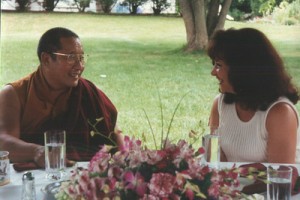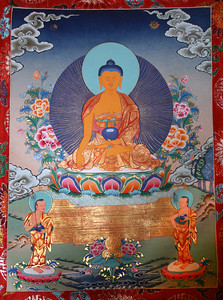The following is an excerpt from a teaching by Jetsunma Ahkon Lhamo offered during a “Good Heart Retreat”
When I start to talk about all of this, it seems like I’m saying, “Okay, go do this, and go do that.” Please don’t hear it that way. I wish that there was some way you could not hear so much with your ears, so that they go in two different channels and you have all those voices in your head arguing with you. But instead hear it with your heart and really kind of vibes with the spirit of the message that I’m putting out here. Again I’m encouraging you not to keep your practice outside as this isolated separate little phenomena that you do in your prayer room. But remember I’m asking you to integrate your faith into your life. To make it real. If we are talking about impartiality, equanimity, and purifying the poisons, then we are talking about abolishing hatred, greed, ignorance, jealousy, and pridefulness. We are talking about making the world a better place—to see as the Buddha has taught us. Really see it. Really get it. In our nature, we are the same. This is what the Buddha has said. In our nature we are the same. To really get that. You can’t do that by simply running around doing all these things that I’m telling you to do. Make a foundation, collect some soup, you know, buy a couple of Christmas presents. That’s not how it’s going to happen.
I have another revolutionary idea. Supposing, once again, you were to really get into your path in such a way as to get into the mysticism of your path. Not simply by visualizing properly, not simply by memorizing the entire Celestial Palace Mandala, so that you have every little bit of it just right. I don’t mean that. If you can do that, it’s great. But in the meantime while you’re doing that, let’s also do something else. Let’s have a mystical experience, shall we? I mean how hard can it be? We’re Buddhists. We’re supposed to be mystical. So rather than talking about the end of ethnic prejudice, the end of hatred, the end of pride, the end of greediness, instead of talking about it, what if we really practiced it and felt it in our practice. Supposing we could kick off this grand idea of being a spiritual community in the world by actually feeling it, by actually doing it in our practice and in our prayers. Supposing we together as a Sangha were to gather periodically and do a meditation. Oh, wow! It’s not written down in the Buddhist books! That’s okay. It’s not a sin to do this. I mean, you know, it’s a funny thing. We have this idea that since we’ve become Buddhist and our prayers are written down in here, we don’t get to say any others. You only get to say those, in Tibetan. Like the Buddhas are up there and they don’t understand anything but Tibetan. If you talk to them, they aren’t really listening, they only talk to the Asians. That’s ridiculous, isn’t it? That’s impossible.
So supposing that we, as Buddhist practitioners had meditations. These are meditations that I like to do by myself. What if we did these as a group together? What if we sat in meditation, simply watching the breath as we do in Vipassana meditation or in shiney meditation, simply gentle meditation with no particular visualization. In our meditation we would relax the mind and abide naturally in the natural state, simply watching the breath as the Buddha has taught. But from that point, what if in this meditation, abiding gently in the nature, we were to expand our view to include first, everyone that we were praying with, to celebrate in meditation, in practice, and in truth, one nature, to meditate gently and abide naturally together. If it’s possible for one, it’s got to be possible for all of us. Supposing after that, we were to reach out, gently, and in that natural state, abiding spontaneously, embrace or include the community around us. Supposing we could recognize that in essence, our breath is the same. Literally, it is. That our breath is the same. Supposing we could understand that in our nature, there’s no place where I end and you begin. Supposing we could do away with those ideas of separation, and in our meditation, expand and embrace till we are meditating as one people. Supposing we could go a little further and meditate as one nation. And what if we could go a little further still and meditate as one world.
Supposing we got so good at this, that in our meditation, we would begin to awaken to the equality and the sameness of all that lives, just like the Buddha said. Supposing in our meditation, we could feel our oneness, our sameness with everybody in Africa, everybody in India, everybody in China, everybody in Europe, everybody everywhere. Supposing we went beyond that to include, as inseparable from that nature, beings who are other species, like the animal kingdom. Supposing we got so good at this that we knew that we were one and could begin to live it. How hard can it be? Nobody’s asking you to work out or anything. All you got to do is sit there and do that. How hard can it be?
And then supposing beyond that we could think about those great pictures they’re sending back from the Hubble telescope. Hmm? We could think about this galaxy and what it looks like. We could think about all the galaxies, those beautiful pictures of all those galaxies in deep space. Have you seen any of those? Oh, breath taking! What if all of that were inseparable from you? What if all of that were inside of you?
Copyright © Jetsunma Ahkon Norbu Lhamo All rights reserved




